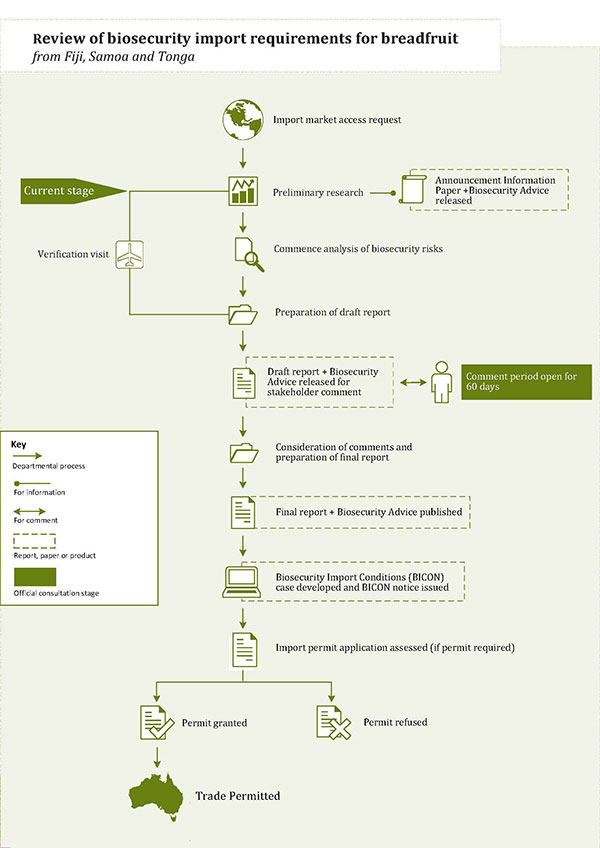Publication details
Department of Agriculture and Water Resources, August 2017
Download
| Document | Pages | File size |
|---|---|---|
Biosecurity Fact Sheet: Fresh breadfruit from Fiji, Samoa and Tonga PDF  | 3 | 864 KB |
If you have difficulty accessing these files, visit web accessibility for assistance.
Online content
[expand all]
Key points
- The Department of Agriculture and Water Resources is conducting a review of biosecurity import requirements for fresh breadfruit from Fiji, Samoa and Tonga.
- A draft report is scheduled to be published in late 2017. Stakeholders can lodge submissions on the draft report during a 60 calendar day formal consultation period.
- The final report is expected to be published in early 2018.
Rationale for the review
Successive Australian governments have recognised that growing export industries in Pacific Island countries and increasing trade opportunities will boost regional economic activity. An important component of this is considering new market access to Australia. Through the Pacific Horticultural and Agricultural Market Access (PHAMA) program, the department implements biosecurity policies that ensure safe agricultural trade from Pacific Island countries to Australia. This involves considering access for new commodities as well as improving existing trade pathways.
A review of biosecurity import requirements for fresh breadfruit has commenced in response to requests for market access for fresh breadfruit from Fiji and Samoa. The review has been expanded to cover Tonga.
The pests associated with fresh breadfruit from Fiji, Samoa and Tonga that are identified as potentially being of quarantine concern are fruit flies and mealybugs. With Australia having already established phytosanitary measures for these pests for other horticultural commodities, this analysis will be conducted as a review of biosecurity import requirements (a non-regulated risk analysis).
Australia’s established phytosanitary measures include high temperature forced air (HTFA) treatment for fruit flies, and phytosanitary inspection and pre-export clearance for mealybugs.
If new information about pests and diseases of fresh breadfruit in this region comes to light as the review progresses then this will be considered.
Australia's trading obligations
The department applies rigorous science to applications from our trading partners to gain access to Australian markets. As a member of the World Trade Organization, Australia bases its import policies on the same science our export markets must use when assessing Australian commodities.
Breadfruit production
Breadfruit (Artocarpus altilis) is a member of the Moraceae (mulberry) family and is closely related to jackfruit (Artocarpus heterophyllus) and breadnut (Artocarpus camansi).
The fruit are variable in size, shape and surface texture but are usually round, oval or oblong in shape, around 9–20 centimetres wide, can be more than 30 centimetres in length, and typically weigh around 1–4 kilograms.
Breadfruit is generally consumed when mature, but not yet ripe. Mature fruit have potato-like starchy qualities, and can be used for curries, stews, fries and salads, and are used in many processed products.
As the breadfruit ripens the starches are gradually converted to sugars, and the fruit can be eaten raw or used for many types of desserts.
The Australian breadfruit industry is very small, with small scale commercial production in the Northern Territory (around Darwin) and Queensland (north of Cairns). Breadfruit production in Australia is seasonal, with peak production occurring in February and March. The fruit is available at fresh produce markets in some of the major cities when in season.
Australia currently imports baked breadfruit from Samoa and frozen breadfruit from all countries, but has not previously imported fresh breadfruit.
There are no breadfruit exports from Australia.
Process for the review
The objective of the review is to ensure that any fresh breadfruit received in Australia are free from unwanted pests and diseases.
The department’s technical specialists will identify any unwanted pests and diseases that might be found on fresh breadfruit from Fiji, Samoa and Tonga and are not present in Australia. They will assess the risk of pests and diseases being brought in on fresh breadfruit.
Department staff will liaise with representatives of industry and relevant state and territory agriculture authorities to gather stakeholder input to ensure the department has all available scientific information relevant to this review.
An overview of the non-regulated risk analysis process for breadfruit is illustrated in Figure 1.
Stakeholders are invited to register their interest online to receive regular updates and contribute to the development of the draft report.
A draft report is scheduled to be published in late 2017. Stakeholders will be notified of the release of the draft report for public consultation through a Biosecurity Advice. Stakeholders will be able to make submissions on the draft report, for consideration by the department, during a 60 calendar day formal consultation period.
The final report is expected to be published in early 2018.
Further information
Further information on the review can be found in the Biosecurity Advice and Announcement Information Paper or by contacting the department.
The department will share information and answer questions relating to this review at any time during the process. New scientific information will also be considered at any time (even after the risk analysis process is completed).
See contact details below.
Plant Sciences and Risk Assessment +61 2 6272 5094
Email: Plant

